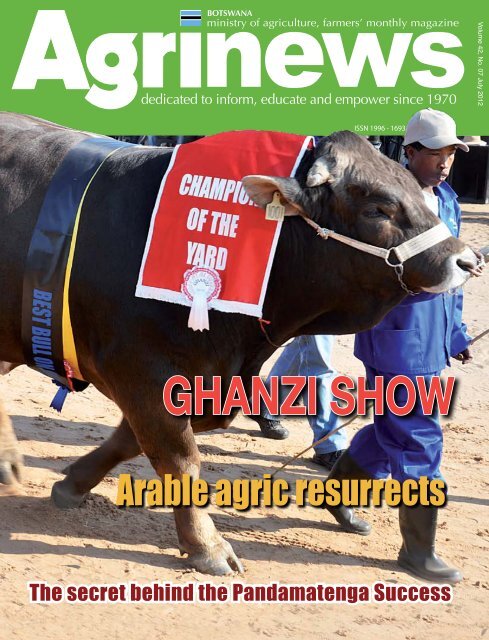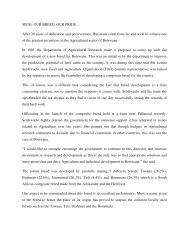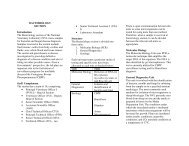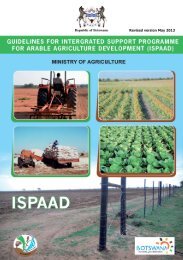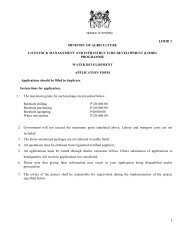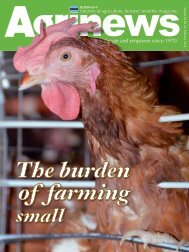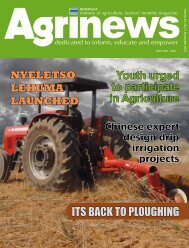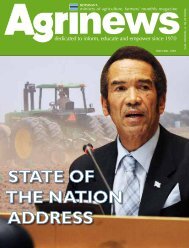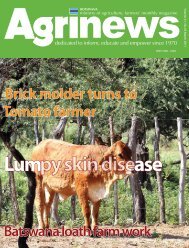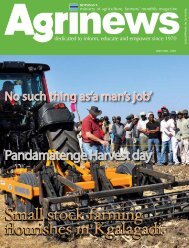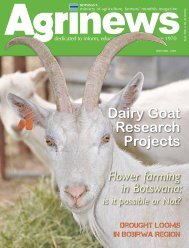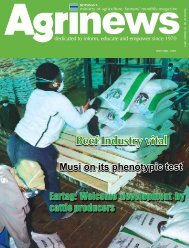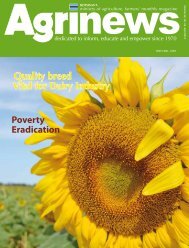GHANZI SHOW - Ministry of Agriculture
GHANZI SHOW - Ministry of Agriculture
GHANZI SHOW - Ministry of Agriculture
You also want an ePaper? Increase the reach of your titles
YUMPU automatically turns print PDFs into web optimized ePapers that Google loves.
Volume 42, No. 07 July 2012<br />
<strong>GHANZI</strong> <strong>SHOW</strong><br />
Arable agric resurrects<br />
The secret behind the Pandamatenga Success
RAINWATER GULLEY <br />
DRAIN GULLEY <br />
ACCOMODATION <br />
EXTERNAL FURNITURE <br />
CATTLE FEEDERS / SALT <br />
LICKS 750 – 3000MM <br />
RAINWATER STORAGE <br />
TOILETS <br />
GOATS/SHEEP/POULTRY <br />
TROUGHS 300 ‐450 MM <br />
CATTLE TROUGHS 600MM
NATIONAL AGRICULTURAL <strong>SHOW</strong><br />
"Transforming <strong>Agriculture</strong> In The Wake Of Climate Change"<br />
"Transforming <strong>Agriculture</strong> In The Wake Of Climate Change"<br />
NEW<br />
NEW<br />
AGRICULTURAL<br />
AGRICULTURAL<br />
<strong>SHOW</strong><br />
<strong>SHOW</strong><br />
GROUND<br />
GROUND -<br />
Sebele<br />
Sebele<br />
27<br />
27<br />
August<br />
August - 1<br />
September<br />
September<br />
2012<br />
2012<br />
For more information call 3689115<br />
For more information call 3689115
A G R I N E W S<br />
J u l y<br />
2012<br />
Contents<br />
First time lucky champion hen winner<br />
Arable farming resurrects in Ghanzi<br />
2<br />
14<br />
The secret behind the Pandamatenga Success<br />
Financial Institutions now have appetite for<br />
<strong>Agriculture</strong><br />
4<br />
6<br />
Ghanzi Show<br />
Batswana Embrace Artificial Insemination<br />
Ghanzi show a marvel once more<br />
National fruit tree nursery grows<br />
Pandamatenga harvest day<br />
8<br />
10<br />
12<br />
13<br />
14<br />
10<br />
Questions and Answers<br />
16<br />
8<br />
Word grid<br />
Teasers<br />
18<br />
19<br />
4<br />
Vacant<br />
Editor:<br />
Moreri Moesi<br />
Reporters:<br />
France Begensel<br />
Segomotso Basuti<br />
Keamogetse Boitshepo<br />
Keseg<strong>of</strong>etse Tawele<br />
Mokgarebe Motswakhumo<br />
Esther Nkgwang<br />
Modiegi Madumetsa<br />
Khutsafalo Maabong<br />
Keabetswe Molebatsi<br />
Designer:<br />
Advisor N. Kapoko<br />
Head Of Photography<br />
Henry Toto<br />
Photographers:<br />
Pius Nkunda<br />
Aggripah Willie<br />
http://www.facebook.com/AgrinewsMagazineMoa?ref=tn_tnmn<br />
July 2012
VISION<br />
FOUNDATION<br />
PILLARS<br />
editor’s note<br />
Farmers must capitalize on Banks’ advances<br />
Attain national food security<br />
and global competitiveness<br />
in agricultural products<br />
MISSION<br />
To improve agricultural productivity<br />
through technology development<br />
and transfer, diversification and<br />
commercialization, in order<br />
to promote food security in<br />
partnership with our stakeholders.<br />
VALUES<br />
1. BOTHO<br />
We treat our customers in<br />
a respectable and caring manner.<br />
2. TEAM WORK<br />
We recognize the need to work as<br />
a team characterized by collective<br />
effort, trust, understanding,<br />
support and perseverance<br />
irrespective <strong>of</strong> rank or gender.<br />
3. CUSTOMER FOCUSED<br />
Our customers are the focus<br />
<strong>of</strong> everything we do by being<br />
courteous, caring, compassionate,<br />
tolerant and empathetic.<br />
4. INNOVATIVE<br />
We commit to employ new ideas<br />
and being proactive in order to<br />
match the requirements <strong>of</strong> the<br />
future.<br />
5. INTEGRITY<br />
We foster a culture <strong>of</strong> transparency,<br />
accountability and dependability.<br />
Besides harsh climatic<br />
conditions, lack <strong>of</strong> capital<br />
has always hampered the<br />
growth <strong>of</strong> the country’s agricultural<br />
sector. Capital is a must for any<br />
farmer. For established farmers<br />
working capital is required while<br />
new ones need start up capital.<br />
Just like the agricultural sector<br />
itself, money is the genesis and<br />
the revelations <strong>of</strong> everything.<br />
Financial institutions had<br />
for many years shunned the<br />
agricultural sector because <strong>of</strong><br />
its associated high risk. This is a<br />
sector, which <strong>of</strong>ten is hated by<br />
many, but cannot be ignored.<br />
The agricultural sector has<br />
proved to be at the heart <strong>of</strong> every<br />
nation <strong>of</strong> the world. Botswana is<br />
not a exemption. It has no option<br />
but work the sector up the ladder<br />
to where it belongs. However,<br />
reaching the altar does not come<br />
cheap; it requires microscope<br />
focus.<br />
It needs all farmers to know<br />
their balance sheet. Gone are<br />
the days when farming was just<br />
a hobby or part time activity. We<br />
need to know our breakeven<br />
point.<br />
Armed with proper records,<br />
f a r m e r s c a n n o w s a f e l y<br />
approach commercial banks to<br />
invest in our beloved pr<strong>of</strong>ession.<br />
Banks believe in figures and<br />
therefore only those who keep<br />
records can pen agreements<br />
with the banks.<br />
Farmers had over the years<br />
t r i e d t o p r o p o s e f i n a n c i a l<br />
i n s t i t u t i o n s f o r a h o l y -<br />
matrimony, but the latter was<br />
reluctant because they were<br />
not sure about the proposer’s<br />
assets. Now, the commercial<br />
banks are warming up to the<br />
proposal.<br />
Hence, commercial banks<br />
are now developing different<br />
products for farmers. It is this<br />
products that we want to urge<br />
farmers to exploit to maximize<br />
production. Diamonds are not<br />
forever, but the agricultural<br />
sector is.<br />
We want to urge commercial<br />
banks to develop more products<br />
to assist farmers and open up to<br />
the farming community for the<br />
benefit <strong>of</strong> the world and those<br />
who live in it. WE need each<br />
other like a bride and groom.<br />
i<br />
July 2012
Malebogo Motlhankamotho with her champion hen<br />
Their noise may be sheer nuisance to<br />
someone standing afar, but for one<br />
in the chicken business every cluck,<br />
chatter or squalk is a heaven sent melody.<br />
One needs to know them in order to be<br />
rewarded well by them. In a nutshell,<br />
poultry business is no walk in the park.<br />
Missing one step in their growth can lead<br />
to jeopardy and great loss.<br />
Australorp and Orpinton breeds dominate<br />
Malebogo Motlhankamotho’s chicken<br />
Coop. The 27 year old Kang based farmer<br />
based was browsing a magazine one day<br />
when her eyes gazed at these birds for<br />
the first time.<br />
One would say it was love at first sight<br />
as from that moment, she knew she had<br />
to change the breed in her pen. She<br />
started with two Orpinton hens and one<br />
cock. At the moment, she has a total <strong>of</strong><br />
12. This might seem like a small number<br />
but considering the fact that they have a<br />
P500.00 price tag attached to them this<br />
is a step in the right direction to riches.<br />
“The problem with these breeds is you<br />
cannot feed them with just everything like<br />
we do with our Tswana breed, if you do<br />
so their growth becomes stunted and do<br />
not perform to the best <strong>of</strong> their ability,”<br />
she said. From what was displayed during<br />
the Ghanzi District <strong>Agriculture</strong> show, one<br />
would say the district is a hub for chicken<br />
farming magnates. The finest chicken<br />
breeds are found here.<br />
As a new comer in the rearing<br />
business one would be intimidated<br />
but sometimes you need to put your<br />
fear in the pocket and just plunge.After<br />
scooping the P2000.00 prize for the<br />
Champion Hen, Motlhankamotho could<br />
not hide her joy especially that it was<br />
her first time to exhibit at the Ghanzi<br />
show. As is everyone’s desire to grow,<br />
Motlhankamotho is no exception. She<br />
has aspirations <strong>of</strong> expanding her project<br />
through financial assistance from the<br />
FIRST TIME LUCKY<br />
CHAMPION HEN WINNER<br />
Article: Segomotso Basuti<br />
Photos: Aggripah Willie<br />
Department <strong>of</strong> Youth and Culture.<br />
Tiro Tlalang working in the Poultry<br />
Production <strong>of</strong>fice and based in Kang<br />
clarified exactly what they consider<br />
to come with the best winner for the<br />
competition. He states that management<br />
is one aspect <strong>of</strong> consideration and these<br />
include being free from deformities, fleas<br />
and having the right colour.<br />
“There are various factors that may lead<br />
to chickens having bad colour, these<br />
may include not feeding them correctly<br />
and if there is too much tempering in the<br />
crossing process this may affect the colour<br />
<strong>of</strong> the particular bird.”<br />
Tlalang states that the overall<br />
performance <strong>of</strong> chickens in the district<br />
is remarkable. After five years <strong>of</strong> judging<br />
in the Ghanzi show, he states that farmers<br />
heed the advice they have been given over<br />
the years as estimated by improvement <strong>of</strong><br />
chickens brought in every year.<br />
“Our main task is not just to judge but<br />
to give technical advice where we see fit,<br />
and from what we have observed there<br />
has been significant growth in farmers<br />
here.”<br />
Tlalang said for Motlhankamotho to<br />
come out a champion, all categories<br />
participating had to be judged. The<br />
categories included Commercial Breeds,<br />
Tswana Breeds, the Pure Breeds and lastly<br />
the Ornamental ones.<br />
“When all judging is complete, we<br />
then take the winners from the stated<br />
categories, judge them all together again<br />
and come up with the Champion Hen.”<br />
Giving advice, Tlalang said what he<br />
observed a trend portrayed by most<br />
farmers <strong>of</strong> using one cock for a long time<br />
which in the end caused in-breeding.<br />
He advised that they replace the cock<br />
regularly so that their chickens maintain<br />
good qualities.<br />
July 2012 2
After years <strong>of</strong> stumbling along<br />
in the dark, arable farming<br />
could well be on its way to<br />
reclaiming its rightful place as a key<br />
part <strong>of</strong> agriculture space in Ghanzi.<br />
Over the years, the area was dominated<br />
by livestock keeping. However, this<br />
might change as dry land farming<br />
has a potential <strong>of</strong> growth in Ghanzi<br />
district. This was evident at this year’s<br />
Ghanzi show, first time in years there<br />
were around 108 arable exhibitors at<br />
the show. Over the years, the Ghanzi<br />
show has been dominated by livestock<br />
exhibits so the increase in arable<br />
exhibits shows an elevated amount<br />
<strong>of</strong> growth in terms <strong>of</strong> arable farming.<br />
Some <strong>of</strong> their exhibits included<br />
beans, sunflower, oranges,<br />
maize, and groundnuts.<br />
This development could be<br />
attributed to the introduction<br />
<strong>of</strong> the Integrated Support<br />
Programme for Arable<br />
Agricultural Development<br />
(ISPAAD).<br />
Th r o u g h<br />
t h i s G o v e r n m e n t<br />
initiative we could witness dry land<br />
farming being widely embraced like in<br />
the olden times. This was confirmed by<br />
the District Agricultural Supervisor, Mr<br />
Diphetogo Spencer Makuku “people<br />
here were planting but due to lack<br />
<strong>of</strong> harvest they sat back but since<br />
ISPAAD we encounter a tremendous<br />
comeback.” he said. He went on to<br />
say that with the arrival <strong>of</strong> new farming<br />
technologies and free distribution <strong>of</strong><br />
fertilizers people have become very<br />
positive. He added that four people<br />
have even bought<br />
tractors to hire<br />
out to others.<br />
M a k u k u<br />
encouraged<br />
farmers to<br />
e m b r a c e<br />
a r a b l e<br />
f a r m i n g<br />
alongside livestock farming. He<br />
asserted that Batswana cannot live<br />
on milk and meat alone, hence the<br />
need to diversify. Through ISPAAD,<br />
farmers could increase their hectarage<br />
in order to sell surplus as well as feed<br />
their livestock with farm litter. He<br />
noted that Botswana imports a lot<br />
<strong>of</strong> agricultural products. One <strong>of</strong> the<br />
farmers who enjoy the dividends <strong>of</strong><br />
engaging in arable farming is Mr Besa<br />
Dabe <strong>of</strong> Grootlaagte. He describes<br />
himself as a small scale subsistence<br />
farmer who thrives on beans and<br />
maize. He ploughed one hectare <strong>of</strong><br />
beans and harvested eight 50kg bags.<br />
He sold four and kept another four<br />
for consumption and replanting in<br />
the next season. He planted maize in<br />
another half ha <strong>of</strong> which he sold to<br />
the local school. He boasts <strong>of</strong> two first<br />
prize awards he won at the Ghanzi<br />
Agricultural Show for the beans.<br />
Dabe reveals that he planted after<br />
the first rains which start in October<br />
and November. He observed that rains<br />
that come between January and March<br />
are heavy and it is the time when<br />
ngadule (aphids) is most prevalent.<br />
It is very destructive to beans; it<br />
sucks the flower nectar until it wilts.<br />
Moreover, after the March rains<br />
weeds come out in abundance and<br />
are difficult to control.<br />
July 2012
THE SECRET<br />
BEHIND THE<br />
PANDAMATENGA<br />
SUCCESS<br />
Article: Keamogetse Boitshepo<br />
Improved technology in use in Pandamatenga<br />
” Botswana Food Basket” like<br />
is commonly referred to lay<br />
stretched 50 000 hectares<br />
about 900 kilometers north <strong>of</strong><br />
Gaborone in a fertile black cotton<br />
soil <strong>of</strong> Chobe. Pandamatenga<br />
commercial farms prove annually<br />
to have the potential to pioneer<br />
commercial farming in Botswana.<br />
In only 12% <strong>of</strong> the hectares planted<br />
in Botswana, Pandamatenga<br />
commercial farms produce about<br />
90% <strong>of</strong> the locally produced cereal<br />
grain.<br />
In 2010/11 planting season, the<br />
farmers planted 22 000 hectares<br />
and produced 43 000 tonnes <strong>of</strong><br />
cereal grain. That means on average<br />
Pandamatenga commercial farms<br />
produce 2.5 tonnes per hectare.<br />
Most arable farmers cry foul over<br />
lack <strong>of</strong> rains and prevalent weeds<br />
and pests producing on average<br />
200kg <strong>of</strong> cereal grains per hectare.<br />
The big questions is; what is<br />
Pandamatenga commercial farmers<br />
doing different?<br />
Agrinews had an exclusive<br />
interview with Mr Tienie Kruger, the<br />
chairperson <strong>of</strong> the Pandamatenga<br />
Commercial Farmers Association<br />
(P.C.F.A).<br />
Kruger explains that just like<br />
Rome was not built in one day,<br />
Pandamatenga as well took years <strong>of</strong><br />
hard work to build. He reminisces<br />
<strong>of</strong> the time the farms were nearly<br />
closed due to frequent floods that<br />
affected farming processes resulting<br />
in the farms operating at a loss.<br />
At the time, he said government<br />
established a commission which<br />
resulted in government investing<br />
millions <strong>of</strong> pula on drainage work<br />
and access roads.<br />
He credits the then President<br />
Festus Mogae and Minister <strong>of</strong><br />
<strong>Agriculture</strong> Jonny Swartz as pioneers<br />
<strong>of</strong> the change in Pandamatenga.<br />
“What you see today is the<br />
expansion <strong>of</strong> Panda farms and<br />
drainage system being put in place.<br />
Additional land <strong>of</strong> 22 000 hectares<br />
was initiated by this two people and<br />
an investment <strong>of</strong> P400 million was<br />
made available to support farmers.”<br />
Kruger was quick to give the farmers<br />
credit for their perseverance, which<br />
somewhat inspired the government<br />
to take action. He, however, could<br />
not over emphasize the importance<br />
<strong>of</strong> government involvement in<br />
farming and cooperating with<br />
farmers.<br />
According to Kruger, government<br />
assistance did not swipe away all<br />
their challenges as by then they<br />
were struggling to understand the<br />
black cotton soil. With time and<br />
improvement <strong>of</strong> equipment and<br />
chemicals he said they discovered<br />
better ways <strong>of</strong> planting the area.<br />
Out <strong>of</strong> that, two schools <strong>of</strong> thoughts<br />
were born, the old and the new but<br />
all practice precision planting.<br />
The old school which Kruger also<br />
subscribes to include harrowing or<br />
disking <strong>of</strong> field; that is doing various<br />
processes <strong>of</strong> preparing the seed bed<br />
before planting. The new school <strong>of</strong><br />
thought does minimum tillage and<br />
is more chemical based as opposed<br />
to ploughing and preserving the soil.<br />
He, however, said both schools<br />
ascribe to improved crop population,<br />
seed depth and other processes that<br />
July 2012 4
Kruger<br />
avoid compaction to enhance their<br />
yield.<br />
“When you drive around you will<br />
find little roads that are used year<br />
after year when plowing, planting<br />
and applying fertilizers. As such<br />
avoid soil compaction on the whole<br />
field by tractor wheels.”<br />
Whilst the farms are known to<br />
produce mainly sorghum, there is<br />
a shift to include beans and sun<br />
flower. Kruger explains that it is<br />
due to rotational planting which<br />
is inevitable in arable farming. He<br />
said beans for instance are taken<br />
to be rotational crops because they<br />
provide the soil with nitrogen.<br />
The use <strong>of</strong> improved technologies<br />
which include heavy machinery,<br />
improved seeds and fertilizers have<br />
grown to be an integral part <strong>of</strong><br />
Pandamatenga culture. According<br />
to Kruger, farming is commercial in<br />
Pandamatenga and treated as such.<br />
Therefore, farmers stop at nothing to<br />
maximum yield in their farms.<br />
“We have good relations with<br />
chemical companies who test our<br />
soil samples to determine a suitable<br />
fertilizer. We also have relations<br />
with seed producing companies<br />
who recommend improved seeds<br />
that improve our yield. We go to<br />
the extent <strong>of</strong> buying seeds as far as<br />
Australia.”<br />
A network <strong>of</strong> investor relations<br />
who <strong>of</strong>fer services, supply inputs<br />
and advice on their expertise<br />
are <strong>of</strong> paramount importance in<br />
Pandamatenga. Kruger revealed that<br />
such partnerships train and make<br />
periodic strategic assessment on the<br />
use <strong>of</strong> their products.<br />
Kruger also emphasized the<br />
importance <strong>of</strong> financial advisers in<br />
farming since it is a risky business.<br />
Taking into consideration that they<br />
make a lump sum ones a year,<br />
financial management is vital.<br />
He said a budget for the next<br />
planting season and wage bill for<br />
unproductive months needs to be<br />
taken into consideration.<br />
Further, he said insurance is a<br />
touchy topic for farmers because<br />
whilst is <strong>of</strong> utmost importance it<br />
is still a matter on the table. He,<br />
however, said for their sort <strong>of</strong> farming<br />
one has to make arrangements with<br />
various institutions to cater for<br />
difficult times.<br />
In the year 2019, with the<br />
completion <strong>of</strong> the north water<br />
pipeline, farmers in Pandamatenga<br />
will have a better chance <strong>of</strong> pumping<br />
water from the Zambezi River, hence<br />
practice irrigation. Kruger said then<br />
Pandamatenga commercial farms<br />
will be a real “food basket” because<br />
they will be able to harvest twice a<br />
year hence double their produce.<br />
APOLOGY<br />
On our June issue, Page 7 on the<br />
story headlined “ Cluster Fencing to<br />
enhance Production in Mookane”<br />
we erroneously reported that LIMID<br />
programme has a cluster fencing<br />
package. The correct version is<br />
that ISPAAD (Integrated Support<br />
Programme for Arable Development)<br />
is the one with the Cluster fencing<br />
c o m p o n e n t . We r e g r e t t h e<br />
inconvinience.<br />
Thank you<br />
Editor<br />
5<br />
July 2012
Whatever the sector in<br />
the economy, financing<br />
r e m a i n s a h u g e<br />
determinant <strong>of</strong> success and growth.<br />
The agricultural sector is not an<br />
exception. Over the years, the<br />
country’s agricultural sector has<br />
been a victim <strong>of</strong> poor financing.<br />
Financial institutions regarded<br />
agriculture as a high risk business,<br />
therefore avoided talking business<br />
with the farming community.<br />
Reasons included interrelated<br />
production risks such as unreliable<br />
rainfall, pests and diseases (outbreaks<br />
<strong>of</strong> Foot and Mouth Diseases), and<br />
high costs incurred when servicing<br />
remote areas.<br />
However, the country’s agricultural<br />
sector has fundamentally changed<br />
over the past few years, a change<br />
that has affected financing. Most<br />
commercial banks have come on<br />
board and identified agriculture as<br />
an area with huge potential.<br />
As a result, agribusinesses are<br />
becoming financially powerful<br />
and bigger.The challenge though<br />
is that most <strong>of</strong> the farmers are<br />
doing subsistence farming rather<br />
than commercial. It is therefore<br />
important for financial institutions to<br />
venture into agriculture to promote<br />
commercialization.<br />
For the beef farming sector, this<br />
will create major opportunities that<br />
can allow it to grow. Currently the<br />
<strong>of</strong>f-take rates <strong>of</strong> South Africa and<br />
Namibia stand at 17% and 14%<br />
respectively while for Botswana is<br />
merely 13%. Botswana’s average<br />
carcass weight is only 175kg while<br />
those <strong>of</strong> our neighboring countries<br />
such as S.A and Nambia is 220kg<br />
and 180kg respectively. The new<br />
focus by banks will benefit the<br />
beef industry substantially as there<br />
will be pressure for consistency<br />
in application <strong>of</strong> sound farming<br />
practices like vaccination,<br />
deworming and supplementary<br />
feeding.<br />
Therefore, effective management<br />
becomes essential to the farmer.<br />
The same goes for arable farming;<br />
nowadays, farming has become<br />
highly capital intensive. Production<br />
inputs have become expensive<br />
and lack <strong>of</strong> proper farming<br />
implements like tractors, planters<br />
and ploughs could hamper efforts<br />
to commercialize. Therefore, banks’<br />
appetite for agriculture is a very<br />
much welcome development by<br />
farmers and the government.<br />
Banks as financiers have taken<br />
a step forward by participating<br />
in the agricultural space through<br />
implementing agribusiness. Stanbic<br />
Bank has developed funding models<br />
that would give small-scale farmers<br />
access to credit.<br />
According to Mr. Kenneth<br />
Makubate, head <strong>of</strong> Agribusiness<br />
at Stanbic Bank, their bank has<br />
committed itself to the development<br />
<strong>of</strong> agriculture through innovative<br />
funding which enables small-holder<br />
farmers to maximize opportunities<br />
including the purchase <strong>of</strong> direct<br />
inputs like seeds and fertilizers.<br />
However, most <strong>of</strong> their business<br />
is focused mostly on commercial<br />
agriculture. Bank Gaborone on the<br />
other hand had designed insurance<br />
policies targeted at those who<br />
practice organized agriculture like<br />
feedlots.<br />
July 2012 6
11<br />
July 2012
3<br />
4<br />
5<br />
6<br />
7<br />
July 2012 8
2<br />
1<br />
Ghanzi Show<br />
1. Delegates at Ghanzi Show 5. Display <strong>of</strong> Swans<br />
2. Judging <strong>of</strong> Champion Ewe 6. Judging <strong>of</strong> rainfed produce<br />
3. Police Band 7. Show Committee Chairperson,<br />
Mr Jecktor Marambe<br />
4. Cross Kgosidiile, the guest speaker<br />
touring the stall<br />
9<br />
July 2012
BATSWANA<br />
EMBRACE<br />
ARTIFICIAL<br />
INSEMINATION<br />
Products <strong>of</strong> Artificial Insemination<br />
July 2012 10
Article: Segomotso Basuti<br />
Photos: Aggripah Willie<br />
When I retired, I told myself<br />
that I’m going to look after<br />
my cattle for no one can do<br />
a better job than I can.”<br />
These are the words <strong>of</strong> a passionate<br />
farmer. His eyes light up when he talks<br />
about his cattle and the love he has for<br />
them. Mr Tiyapo Sekgopa, told his wife<br />
upon retiring from the public service in<br />
1994 that he decided to go into cattle<br />
rearing full time. He knew it was not<br />
going to be easy, but also knew that<br />
with passion everything was attainable.<br />
In 1994, Sekgopa tried his luck at<br />
Artificial Insemination (AI). He beams<br />
when he counts the advantages <strong>of</strong> using<br />
AI. Though the government allows one<br />
farmer to bring only five cattle to the<br />
AI Centre during insemination season,<br />
he applauds the service as it gives an<br />
opportunity for all farmers to have their<br />
kraals boasting with good breeds.<br />
Sekgopa says that AI increases the<br />
chances <strong>of</strong> conception, adding that one<br />
has power over the kind <strong>of</strong> breed they<br />
desire to dominate their kraal, as the<br />
farmer is given the choice <strong>of</strong> using the<br />
best bulls to come up with the finest<br />
<strong>of</strong>fsprings. To top it <strong>of</strong>f, he says with the<br />
conception rate increasing, one can be<br />
confident that their cows will increase<br />
each breeding season.<br />
Currently, Sekgopa has 104 herds<br />
<strong>of</strong> cattle, 30 being products <strong>of</strong> AI. He<br />
has not yet decided on which breed to<br />
specialize in but the one that seems to be<br />
winning his heart is the Limousine. He<br />
says the reason behind this is because it<br />
does not take a long time to calf.<br />
A Diamond Driller by pr<strong>of</strong>ession,<br />
Sekgopa says he goes back<br />
to work once in<br />
a while on<br />
contract agreement just to increase the<br />
family income, saying that this is the<br />
only time he engages a herd boy to look<br />
after his cattle.<br />
Sekgopa believes that the strategy he<br />
has set for himself works pretty well.<br />
“As I wanted to run my cattle post as a<br />
business, I had to go an extra mile and<br />
learn what I needed in order to achieve<br />
this.”<br />
Teaming up with his son, they collected<br />
material and studied the diseases that<br />
were prone to their area, at Mogotho wa<br />
Dinotshi cattle post, Kweneng.<br />
“Diseases are not really a problem here,<br />
as we take all precautionary measures to<br />
prevent them, the only thing worrisome<br />
is the wild dogs which are very difficult<br />
to ward <strong>of</strong>f.”<br />
Sekgopa says that he has ensured that<br />
cattle maintain themselves. He works<br />
by an inventory where all the activities<br />
taking place in the farm are captured.<br />
“I have bought a laptop which I use to<br />
register everything, from administering<br />
medicine, updating those that have given<br />
birth, those that have died and even those<br />
I have culled as a result <strong>of</strong> not<br />
doing well.”<br />
H e<br />
f u r t h e r<br />
states that<br />
the inventory<br />
also keeps record<br />
<strong>of</strong> those he takes<br />
to A.I camps and<br />
the successful<br />
and unsuccessful<br />
inseminations that<br />
occurred during<br />
breeding period.<br />
Sekgopa believes one cannot progress<br />
if one does not do a documentation <strong>of</strong><br />
the everyday activities <strong>of</strong> his/her farm.<br />
He believes this is the reason he has<br />
continued to do well over the years.<br />
Any livestock farmer in Botswana with<br />
a valid Brand Certificate and Omang<br />
can benefit from the A.I services. The<br />
Principal Scientific Officer, Animal<br />
Breeding, Aubrey Ranko stated that<br />
each farmer is allowed to bring five (5)<br />
cows per brand to be inseminated in a<br />
breeding season.<br />
Breeding season starts in September<br />
and ends in March in government A.I<br />
camps costing the farmer P50.00 for<br />
the 5 cows to be inseminated with<br />
locally collected semen. Ranko said<br />
though there are problems that they may<br />
encounter during breeding season such<br />
as deaths due to diseases and predators,<br />
Batswana have generally embraced the<br />
artificial insemination service.<br />
“The farmers’ response is very positive<br />
because none <strong>of</strong> Government A.I camps<br />
is underutilized and more farmers with<br />
ranches are now venturing into the On-<br />
Farm A.I programme.”<br />
Ranko explained that the most<br />
preferred breed by farmers is the<br />
Brahman, and this could be<br />
attributed to the Tswana type <strong>of</strong><br />
breed that is dominant amongst<br />
local farmers. He said because <strong>of</strong><br />
this small framed Tswana breed,<br />
little or no complications such as<br />
dystocia are experienced during birth.<br />
July 2012
Ghanzi Show A<br />
Marvel Once More<br />
Cross Kgosidiile<br />
Cattle parade at Gantsi show<br />
Article: Segomotso Basuti<br />
Photos: Aggripah Willie<br />
The time came once more for people to<br />
embark on the remarkable pilgrimage<br />
to Ghanzi through the Trans Kalahari<br />
Highway. For most people, this event<br />
is religiously marked on their yearly<br />
calendars and it will be a cardinal sin for<br />
them to miss it. First timers, never resist<br />
the temptation to attain life membership<br />
<strong>of</strong> this event. By all standards, this event<br />
is infectious. Ghanzi District <strong>Agriculture</strong><br />
show has always attracted people from<br />
all corners <strong>of</strong> the country, and outside as<br />
well. Not only farmers but entrepreneurs,<br />
the socialites, and financial institutions to<br />
mention but a few make it to the district<br />
to see what the show has in store for them.<br />
This has been a tradition for years. The<br />
first show to be held was in 1974. When<br />
it started, the dominating aspect <strong>of</strong> the<br />
show was livestock exhibitions. There<br />
has been a significant change over the<br />
years and this year had farmers bringing<br />
forth a good harvest, something which is<br />
not familiar to the show. Though the soil<br />
in the area is generally not good for crop<br />
production, the hunger for farmers to excel<br />
in every part <strong>of</strong> agriculture led to them<br />
sticking to those crops that do well in<br />
Ghanzi district. The show with the theme<br />
“Commercialize <strong>Agriculture</strong>, a solution to<br />
food security and economic development,”<br />
implored Batswana to strive to develop<br />
the country’s agricultural sector in order<br />
to diversify the economy <strong>of</strong> the country. In<br />
his keynote address, the Chief Executive<br />
Officer, Motor Vehicle Accident Fund, Mr<br />
Cross Kgosidiile, acknowledged Ghanzi<br />
District as one <strong>of</strong> the largest cattle farming<br />
areas in Botswana.<br />
“The quality and the number <strong>of</strong> cattle<br />
produced in this area is a sure sign <strong>of</strong> your<br />
commitment in growing the beef industry<br />
<strong>of</strong> Botswana,” he said.<br />
For farmers who travelled many<br />
kilometers to learn from the show, they<br />
were not disappointed. Kgomotso Maroba,<br />
a farmer in Kadijenaa cattle post, Boteti,<br />
said attending such an event makes him<br />
grow as farming is all about learning from<br />
the achievements <strong>of</strong> others.<br />
“I really regret not coming with a van<br />
because this year the bucks are selling<br />
like fat cakes, I could have got myself<br />
one or two.”<br />
Giving a review <strong>of</strong> the preparation<br />
<strong>of</strong> the show before the multitudes that<br />
gathered there, the chairperson <strong>of</strong> the<br />
show committee, Mr Jecktor Marambe<br />
said that they were faced with the<br />
challenge <strong>of</strong> turning their stumbling<br />
blocks into achievements.<br />
He implored all who took part to<br />
show up for the evaluation meeting as a<br />
way to rectify where they went wrong in<br />
order to come back bigger and better the<br />
following year.<br />
Reflecting on the show, the chairman<br />
stated that it provided a learning curve<br />
each year as every year comes with<br />
growth and changes and more challenges.<br />
“There has been growth as this year we<br />
saw big companies such as Barloworld<br />
and BH Botswana exhibit for the first time<br />
which attracted farmers to the show.”<br />
Marambe said that this causes the<br />
committee to persevere as whatever<br />
happens, either good or bad, there<br />
will always be feedback, and as the<br />
show committee they have to account<br />
for everything that happens during the<br />
event.<br />
July 2012 12
NATIONAL FRUIT TREE<br />
NURSERY GROWS<br />
Botswana is one<br />
<strong>of</strong> the countries<br />
that still import<br />
fruits and vegetables<br />
from other countries<br />
especially South<br />
A f r i c a a t v e r y<br />
costly price. This<br />
has brought about<br />
the idea to establish a<br />
national fruit tree nursery<br />
at Ditladi village, 9km east<br />
<strong>of</strong> Tonota village. The national<br />
year demand for orange trees is<br />
6000, mangoes, leaches and<br />
paw paw stands at 2000.<br />
The national fruit tree nursery<br />
manager, Ms Velleminah<br />
Pelokgale, says “the nursery<br />
was established to among others,<br />
increase fruit production through<br />
establishments <strong>of</strong> orchards in Botswana,<br />
monitor national fruit tree production,<br />
market needs and to generate income.”<br />
The National Fruit Tree Nursery was also<br />
made to develop standards <strong>of</strong> seedlings<br />
quality and evaluating species, provenances,<br />
varieties and other germ plasm through the<br />
establishment <strong>of</strong> gene bank and mother<br />
rootstock blocks. Furthermore, the project<br />
is intended for technical and leadership<br />
capacity building. Pelokgale states that<br />
since its establishment in 2003/4, the<br />
project has promoted a number<br />
<strong>of</strong> projects in the country.<br />
Adding that farmers come<br />
from all over the country,<br />
as far as Okavango and<br />
Tsabong to buy fruit<br />
trees. She reveals that<br />
they propagate fruit trees<br />
seedlings, especially citrus<br />
and mangoes in order<br />
to reduce importation<br />
<strong>of</strong> fruit trees seedlings<br />
from foreign nurseries,<br />
which is expensive to the<br />
government and individuals.<br />
She adds that the nursery users include<br />
nursery operators themselves, individuals,<br />
community organisations, farmers groups,<br />
government agencies and non governmental<br />
organisations including corporate, private<br />
and other stakeholders.<br />
The national fruit tree nursery which is<br />
situated in a 27 hectares area is divided into<br />
four operational divisions which comprise<br />
<strong>of</strong> root stock area which is four hectares and<br />
currently is planted with 182 Eureka lemons<br />
and rough lemons; three hectare gene bank<br />
planted with assorted 263 citrus, 45 table<br />
grapes and 58 olives. The other area is for<br />
mother block and the potting/progation area.<br />
The national fruit tree nursery is located in<br />
a very fertile flat area with good drainage and<br />
good soils and proximity to the Shashe river<br />
where the farm draws its water. The manager<br />
says that the area is readily accessible, which<br />
makes it a good venue for training and field<br />
visits by students from various institutions,<br />
nursery operators and interested groups. She<br />
also reveals that the staff <strong>of</strong>ten act as trainers<br />
and commonly is accomodative and willing<br />
to assist. Pelokgale adds that the area’s semimodern<br />
infrastructure complimented by<br />
moderately trained staff ensures that their<br />
small industrial nurseries are outstanding<br />
training venues for basic and advanced<br />
nursery propagation techniques.<br />
“The extensive nursery facility was<br />
established to achieve the staggering seedling<br />
and land rehabilitation in Botswana.”<br />
The nursery imports cuttings from South<br />
Africa and later multiplies them. She says<br />
that they follow international importation<br />
bilateral laws and rules, adding that they<br />
only buy from accredited nurseries. And that<br />
only the government through the <strong>Ministry</strong> <strong>of</strong><br />
<strong>Agriculture</strong> imports such plants. Pelokgale<br />
reveals this is to ensure no plants from non<br />
accredited nurseries cross into the coutry.<br />
The main reason being to avoid diseases,<br />
pests like fruit fly crossing over. She says<br />
that it would not be easy to control such<br />
if individuals were to import on their own,<br />
stating that with individuals anything could<br />
happen.<br />
Ms Pelokgale posits that the project faces a<br />
Ms Vellemiah Pelokgale says there is a high<br />
demand for citrus plants countrywide<br />
number <strong>of</strong> challenges. She says that it is very<br />
expensive to run the nursery adding that it<br />
is incomplete. She adds that the netshadings<br />
need to be paved inside. She says that if the<br />
area was paved it was going to be easy to<br />
disinfect after taking out stock. She also says<br />
that dry land encourages weeds to grow<br />
rapidly as opposed to a green house where<br />
they would not survive because they are not<br />
used to such conditions.<br />
She adds that unpaved floors also result<br />
in sinking, rusting, breaking <strong>of</strong> nursery table<br />
legs and base,resulting in high maintenance<br />
costs. She says that insects are also a<br />
menace adding that termites also harass<br />
their plants. She, however, controls them<br />
by digging out anthills, burning them and<br />
putting insecticides. She posits that there are<br />
incidences <strong>of</strong> non migratory pests such as<br />
thrips,scales,orange dogs, grasshopper and<br />
fruitfly. She also says that as a precautionary<br />
measure to avert diseases they disinfect at<br />
the main gate and at entrances to the green<br />
houses. She says this would avoid carrying<br />
in diseases that might be trapped in shoes<br />
and tyres. The fruit tree nursery develops<br />
citrus/orange varieties like palmer navel,bah<br />
navel, delta valencia, midnite valencia,<br />
maclean,impress mandarine,minowasi<br />
mandarine. Mangoes-tommy atkins, kent,<br />
reitz,zeal. Avocado; mexican and indiana.<br />
Olives; mission corithian. Bananas chinese<br />
dwarf. Peaches; omsreal.<br />
Joel Kokwere says they need funds<br />
to pave tunnels.<br />
13<br />
July 2012
Article & Photos: Keamogetse Boitshepo<br />
Flags <strong>of</strong> various institutions ranging<br />
from financial institutions, inputs<br />
shops, equipment dealers as well<br />
as relevant government departments<br />
decorated the annual Pandamatenga<br />
Harvest Day in rainbow colors.<br />
Even though the event is emulating<br />
the South African Nampo exhibition<br />
concept, is now being customized to<br />
suit the local culture and needs.<br />
According to the Pandamatenga<br />
Commercial Farmers Association<br />
(P.C.F.A) chairperson, Tienie Kruger<br />
the event intends to create a platform<br />
for information and skills exchange<br />
between commercial and small scale<br />
farmers. He, therefore, requested the<br />
<strong>Ministry</strong> <strong>of</strong> Lands and Housing to<br />
allocate 100 hectares <strong>of</strong> land for the<br />
use <strong>of</strong> the event. He said the land will<br />
be developed with proper structures to<br />
ensure the event’s growth and success.<br />
Displays <strong>of</strong> different heavy duty<br />
agricultural machinery <strong>of</strong> various<br />
dealers created an excitement that<br />
was evident in people as they went<br />
around looking at the implements.<br />
The appearance <strong>of</strong> the venue in many<br />
ways depicted the theme, “Unity<br />
and technology <strong>of</strong> Chobe, filling the<br />
PANDAMATENGA<br />
H A R V E S T D AY<br />
Botswana food basket.”<br />
“ B o t s w a n a f o o d b a s k e t ” , i s<br />
Pandamatenga commercial farms<br />
synonym. This cannot be easily disputed<br />
considering that the cluster produces<br />
90% <strong>of</strong> the locally produced cereal<br />
grain. Driven by their passion to produce<br />
food, the P.C.F.A farmers believe that<br />
up scaling the small scale farmers is a<br />
good remedy to curb the current food<br />
shortage in the country. They intend<br />
to use the annual show to achieve this<br />
goal. This year, the show grew bigger<br />
to include small scale farmers from<br />
Pandamatenga, Paragarungu, Katshikau<br />
and Kavimba.<br />
Kruger said the only way Botswana<br />
could be self sufficient and have food<br />
security is when small scale farmers<br />
become commercial.<br />
“The quicker we can assist<br />
small scale farmers to also become<br />
commercial farmers who can sell their<br />
crops locally the better for all <strong>of</strong> us in<br />
Botswana.”<br />
With the alarming rate <strong>of</strong> population<br />
growth, Kruger said Botswana should<br />
not be caught unprepared like other<br />
countries where food shortage and<br />
starvation are a horrific reality. He<br />
said the looming horror <strong>of</strong> starvation<br />
and hunger was taken lightly by those<br />
countries that are currently stricken<br />
by hunger. As such, Kruger pleaded<br />
with government to reconsider the<br />
ISPAAD package to make provisions<br />
for chemical purchases. With the<br />
current climatic conditions, he said<br />
the use <strong>of</strong> chemicals is imperative for<br />
good crop production.<br />
Demonstration at the Harvest Day<br />
July 2012 14
Kruger,Mokalake, Kgosi Baniki and Molebatsi<br />
admiring one <strong>of</strong> the exhibits<br />
“We see their crop when it is planted<br />
and it compares extremely well with<br />
those <strong>of</strong> commercial farmers, but then<br />
all <strong>of</strong> a sudden it fades away because <strong>of</strong><br />
insects as these crops are not sprayed.”<br />
Kruger said the current ISPAAD<br />
package is good and a commendable<br />
effort by government ,but he termed it<br />
‘half package.’ He, therefore, advised<br />
that it should be made ‘full package’ to<br />
support the efforts <strong>of</strong> small scale farmers<br />
who are currently healing wounds <strong>of</strong><br />
drought <strong>of</strong> the previous planting season.<br />
The Minister <strong>of</strong> Lands and Housing, Mr<br />
Lebonaamang Mokalake praised P.C.F.A<br />
for embracing and facilitating a show<br />
<strong>of</strong> such a nature. With the production<br />
status such events, he said can be used<br />
to promote improved technologies that<br />
can increase production yield.<br />
Mokalake concurred with the vision<br />
<strong>of</strong> growing the event to make it regional,<br />
hence attract attendants from abroad.<br />
“It is my hope that Chobe Harvest Day<br />
should grow in stature to such an extent<br />
that it becomes a regional event where<br />
neighboring countries will attend.”<br />
Further, Mokalake appreciated the<br />
choice <strong>of</strong> the theme and the way it was<br />
portrayed. According to him, unity among<br />
all the arable agriculture stakeholders<br />
is important to pull the country from<br />
the shame <strong>of</strong> importing its staple food<br />
from as far as Australia. He said it goes<br />
without saying that technology has also<br />
characterized farming in Pandamatenga<br />
and enabled them to feed Botswana.<br />
With mechanization, good management<br />
practices and use <strong>of</strong> high yield varieties,<br />
Mokalake said Pandamatega farms have<br />
far much higher productivity rate than<br />
the national average. Reflecting on the<br />
production history <strong>of</strong> Pandamatenga,<br />
Mokalake noted that for the year 2010/11<br />
planting season, about 22 000 hectares<br />
was planted and production was about<br />
43 000 tonnes <strong>of</strong> sorghum. This, he<br />
said, states the obvious that subsistence<br />
farmers have a lot to learn for Botswana<br />
to achieve maximum production from<br />
the 300 000 hectares cultivated under<br />
ISPAAD.<br />
“If other farmers were as productive<br />
as Pandamatenga, we would have<br />
produced enough cereal for local<br />
consumption or even had excess for<br />
export.”<br />
Mokalake praised Pandamatenga<br />
farmers who are tutoring and <strong>of</strong>fering<br />
attachments to small scale farmers.<br />
“These small scale farmers are more<br />
likely to improve their production<br />
methods, because they have learnt<br />
and adapted new production systems<br />
through practice and experience.”<br />
However, Mokalake regretted that<br />
despite efforts by his ministry to avail land<br />
for arable production, a considerable<br />
amount remain uncultivated. He warned<br />
those with uncultivated land to make use<br />
<strong>of</strong> it because soon his <strong>Ministry</strong> will be<br />
forced to repossess the land.<br />
15<br />
July 2012
Questions<br />
&<br />
Answers<br />
Article: Keamogetse Boitshepo<br />
Photos: Aggripah Willie<br />
Agrinews was in Pandamatenga<br />
recently for the Harvest<br />
Day. It became clear that<br />
the Pandamatenga Agricultural<br />
infrastructure development project<br />
is ongoing. Keamogetse Boitshepo<br />
talks to Mr Stanley Semetsa, Project<br />
Manager, Pandamatenga Infrastructure<br />
Development Project.<br />
For those <strong>of</strong> our readers who are not<br />
aware <strong>of</strong> the development, briefly tell<br />
us what Pandamatenga Agricultural<br />
infrastructure development project is?<br />
The Pandamatenga Agricultural<br />
Infrastructure Development Project<br />
was envisaged in 1997, after the<br />
Department <strong>of</strong> Crop Production<br />
realized that the farmers in the area<br />
were experiencing challenges <strong>of</strong> crop<br />
production, which amongst others,<br />
included destruction <strong>of</strong> crops by<br />
wildlife, flooding and inaccessibility<br />
into the farms during the rainy season.<br />
In 2000 the Department <strong>of</strong> Crop<br />
Production erected a 91km electric<br />
fence around the entire 25 040 ha <strong>of</strong><br />
farms. After completion <strong>of</strong> the fence,<br />
the Department embarked on securing<br />
funding to construct a road network<br />
and drainage system. In 2006 the<br />
African Development Bank expressed<br />
interest in funding the project called<br />
the “Pandamatenga Agricultural<br />
Infrastructure Development Project”,<br />
which they subsequently funded in<br />
2009.<br />
What does the project entail?<br />
The project comprises <strong>of</strong> three<br />
components 1) Infrastructure<br />
D e v e l o p m e n t - w h i c h e n t a i l s<br />
construction <strong>of</strong> 180 km <strong>of</strong> gravel<br />
surfaced road, “open drains” drainage<br />
system, and supporting ancillary<br />
infrastructure, 2) Agricultural<br />
Production Improvement-mobilize<br />
farming community and build capacity,<br />
3) Project Coordination-strengthen<br />
capacity <strong>of</strong> the project implementation<br />
team.<br />
When was it started and why ?<br />
The loan was signed in April 2009,<br />
but actual construction started 1st<br />
August 2011. The procurement <strong>of</strong> the<br />
contractor took longer than anticipated.<br />
What has been achieved by far and is<br />
it going according to schedule?<br />
To date the project is at 20% overall.<br />
The project is behind schedule due to<br />
prolonged mobilization period by the<br />
contractor, and the “unworkable” wet<br />
conditions.<br />
The area is underlain by black cotton<br />
soils which are virtually unworkable<br />
when wet.<br />
How is it envisioned to help<br />
Pandamatenga farmers?<br />
One <strong>of</strong> the major objectives <strong>of</strong> the<br />
project is to improve crop productivity,<br />
yields for smallscale farmers will<br />
increase from the current 0.5ton to<br />
2.5 tonnes, whilst for the Commercial<br />
it will increase from 2.5 tonnes to<br />
3.5tonnes.<br />
How is the project intended to improve<br />
the arable agriculture as a whole?<br />
Given that the area contributes about<br />
75% <strong>of</strong> the cereal production in the<br />
country, increase in yield in the area<br />
has a significant contribution to food<br />
security.<br />
When is the project expected to<br />
end?<br />
Completion <strong>of</strong> the project is planned<br />
for 31st July, 2014.<br />
How much is the project estimated to<br />
cost and who is funding it?<br />
The total cost <strong>of</strong> the project is USD<br />
60,020 million (about BWP464 million<br />
at current exchange rate) (will be<br />
financed by African Development Bank),<br />
whilst the Botswana Government will<br />
finance with about USD 8, 1 million<br />
(about BWP 62 million). It is important<br />
to note that at preparatory stage <strong>of</strong> the<br />
project, the African Development Bank<br />
awarded the Government <strong>of</strong> Botswana<br />
two grants at a total <strong>of</strong> about BWP<br />
12million.<br />
July 2012 16
Versions Of Progress<br />
I<br />
love agriculture, I always have.<br />
I am completely spellbound by<br />
germination and by pollination. I<br />
love being in a vet clinic and seeing<br />
faces <strong>of</strong> satisfied animal lovers. I<br />
love the smell <strong>of</strong> cow dung in the<br />
morning. I love the scenery <strong>of</strong> a<br />
typical moraka or masimo. It is a<br />
path that I have always known I will<br />
venture. <strong>Agriculture</strong> is not something<br />
I fell in to, it is a natural talent.<br />
It has not always been easy to admit<br />
as most <strong>of</strong> my peers found humour<br />
in my passion. To this day, some<br />
frown at my decision to choose<br />
such a “dirty” path. With remarks<br />
and questions such as.......A o rata di<br />
plot mo go kalo? Ao gatwe animal<br />
health motho o go boning o leleka<br />
di koko!? Ako loe go koba dikgomo<br />
fa thoko ga tsela. And yes, in social<br />
scenes I choose to say it less loudly....<br />
<strong>Agriculture</strong>??? Oh, o mmalophalo<br />
goriana!<br />
I do not blame them though as youth<br />
in our society have succumbed to<br />
what is deemed “white collar” jobs;<br />
the lawyers, marketing managers,<br />
or IT specialists. See, we are so<br />
used to the idea <strong>of</strong> agriculture being<br />
a required routine in our school<br />
system; a tedious chore <strong>of</strong> watering<br />
the gardens and weeding. Maybe<br />
an enhancement in our school<br />
curriculum would have changed<br />
our mindset.<br />
Am I surprised to find Botswana<br />
with not enough food to feed its<br />
mouth? Our neighbouring friends<br />
Zambia and South Africa have<br />
a different attitude despite their<br />
superior placement <strong>of</strong> resources. A<br />
change in outlook would lift not only<br />
our GDP and production quality but<br />
our natural pride in farming, that our<br />
father`s fathers had. Existing farmers<br />
might then have a nudge to uplift<br />
themselves to a more competitive<br />
state. The right support might find<br />
potential farmers looking for more<br />
diversified ways <strong>of</strong> uplifting the<br />
economy.<br />
I stopped most <strong>of</strong> my friends from<br />
laughing when I made them realise<br />
that, Advocate, Director, or Fashion<br />
designer, it is I the agriculturalist<br />
that takes care <strong>of</strong> your stomach<br />
indiscriminately. Do not bite the<br />
hand that feeds you.<br />
17<br />
July 2012
Compiled by Segomotso Basuti<br />
Word Grid<br />
July Grid<br />
A body <strong>of</strong> still<br />
water<br />
Nothing<br />
Birds’s home<br />
Comes after<br />
Autumn<br />
Food for horses<br />
and cattle<br />
You<br />
and I<br />
A man’s best<br />
friend<br />
A cutting tool<br />
Grass dried for fodder<br />
A confinement for animals<br />
The<br />
thing<br />
Not<br />
hot<br />
Female horse<br />
Eat growing grass<br />
Female<br />
hare<br />
A cattle-breading<br />
establishment<br />
Artificial insemination<br />
(abbr)<br />
Top<br />
mark<br />
What you sow<br />
Barrel<br />
Where plants<br />
are kept<br />
Emergency<br />
Room (abbr)<br />
Yellow part <strong>of</strong><br />
egg<br />
Snakelike Fish<br />
Our neighboring<br />
country<br />
What we breathe<br />
Used for catching<br />
fish<br />
A village in<br />
Botswana<br />
Where animals<br />
are kept<br />
Not<br />
<strong>of</strong>f<br />
North<br />
(abbr)<br />
A cow that’s not giving<br />
milk<br />
Ton<br />
(abbr)<br />
Non government<br />
organization<br />
A fruit<br />
Relating to ions<br />
Sick<br />
Zero<br />
A<br />
vowel<br />
Not<br />
near<br />
Type <strong>of</strong> planting<br />
A leguminous<br />
plant<br />
Where bees are<br />
kept<br />
For your<br />
information<br />
Male sheep<br />
Rub<br />
out<br />
Unwanted Plant<br />
Roman<br />
one<br />
Farm tool<br />
Not<br />
out<br />
Goat Breed Negative Answer Pig<br />
L I M E A citrus fruit In good physical<br />
shape<br />
H E A L T H Y Year<br />
(abbr)<br />
In the middle <strong>of</strong> I H Bee Product U A small house O Type <strong>of</strong> soil R<br />
Period without D R O U G H T First A O A vegetable<br />
rain<br />
vowel<br />
RB1 Agric show N North Gram A pig’s home Animal disease M A N G E<br />
(abbr) (abbr)<br />
M A I Z E Top<br />
Mark<br />
The element<br />
carbon<br />
S K I Glide on snow I A meditation<br />
process<br />
A Cereal plant Y A C H T A light sailing<br />
Y O G A<br />
vessel<br />
T U L I Cattle breed Yellow part <strong>of</strong> Y O L K N N<br />
egg<br />
I Legumes P E A S W O Knockout Ton T<br />
(abbr) (abbr)<br />
M<br />
Botswana Agricultural Marketing I Not O L D Pig Breed G Social insect<br />
Board<br />
new<br />
E W E Not B A D A nocturnal bird D U R O C<br />
good<br />
L A female sheep A Help Diamond town West Last E<br />
Leave<br />
vowel<br />
A U T U M N Informal A<br />
J W A N E N G<br />
greeting vowel<br />
A man’s best O Pull B A H I Local Enterprise Not Water collection T<br />
O<br />
friend<br />
season<br />
Authority (abbr) you source<br />
D E W Atmospheric Government assistance L I M I D Address welcomingly<br />
vapour programme<br />
O<br />
Not<br />
<strong>of</strong>f<br />
O X Farm animal East E E A Not<br />
out<br />
I Not<br />
yours<br />
G R I N Smile broadly C L A Y Type <strong>of</strong> soil M I N E<br />
June<br />
solutions<br />
July 2012 18
Teasers<br />
Compiled By Segomotso Basuti<br />
Did you Know?<br />
Field crops can be found in<br />
a w i d e va r i e t y o f e ve r y d ay<br />
household products, including<br />
cosmetics, dyes, clothing and<br />
more.<br />
Did you Know?<br />
A m a t u r e s h e e p w i l l e a t<br />
approximately three kg <strong>of</strong> hay<br />
and grass per day. Weaned lambs<br />
will eat about one kg <strong>of</strong> grain and<br />
one kg <strong>of</strong> hay or grass every day.<br />
Did you Know?<br />
A cow will spend approximately<br />
six h o u r s a d ay e a t i n g and<br />
approximately eight hours a day<br />
chewing its cud.<br />
Did you Know?<br />
Bees have two stomachs - one<br />
stomach for eating and the other<br />
special stomach is for storing<br />
nectar collected from flowers or<br />
water so that they can carry it<br />
back to their hive.<br />
Did you Know?<br />
Chickens are omnivores; in the<br />
wild a chicken will dine on<br />
plants but it will also snack on<br />
bugs and slugs and other meat<br />
protein sources.<br />
Did you Know?<br />
Each mature beef animal will drink<br />
between 35 and 65 litres <strong>of</strong> water<br />
every day depending on their feed<br />
source and the outside temperature.<br />
Did you Know?<br />
Dairy cows give an average <strong>of</strong> 27<br />
litres <strong>of</strong> milk per day.<br />
Did you Know?<br />
The first meal the calf receives<br />
from its mother is thick, sticky milk<br />
called colostrum. This milk contains<br />
antibodies that provide them with<br />
immunity to disease. After two to<br />
three days, the colostrum changes<br />
to milk.<br />
Did you Know?<br />
Milk can be processed into cheese,<br />
butter, ice cream, yogurt, cream<br />
cheese, sour cream, skim milk<br />
powder and more.<br />
Did you Know?<br />
A queen bee may lay as many as<br />
2,000 eggs in a single day.<br />
Did you Know?<br />
Honey is 25 per cent sweeter than<br />
sugar because <strong>of</strong> its high fructose<br />
content.<br />
19<br />
July 2012
LENANEO LA DITSHUPO TSA TEMO THUO, 2012<br />
REGION DISTRICT DATE VENUE<br />
CONTACTS<br />
Southern(Kanye) 1. Jwaneng<br />
Pitseng<br />
DAO 5803100<br />
2. Mmathethe Motsentse<br />
DAO 5400086<br />
3. Kanye Kanye<br />
DAO 5440279<br />
4. Moshupa Manyana<br />
DAO 5449112<br />
5.Goodhope<br />
Good hope<br />
DAO 5486231<br />
Western (Kang) 1. Ghanzi 23-25 June 2012<br />
Ghanzi<br />
DAO 6596217<br />
Ms Makabeletso L/board 6596236<br />
2. Tsabong<br />
Tsabong<br />
DAO 6540300<br />
3. Hukuntsi<br />
Tshane<br />
DAO 6510261/242<br />
Maun<br />
1.Ngamiland<br />
west(Gumare)<br />
2. Ngamiland<br />
East(Maun)<br />
27,28 July 2012<br />
Gumare<br />
6874055/9<br />
1-4 Aug 2102<br />
Maun<br />
DAO 6860579/230<br />
3. Chobe ( Kasane) 29-30 June 2012<br />
Pandamatenga<br />
DAO 6250211<br />
4. Okavango<br />
(Shakawe)<br />
Shakawe<br />
DAO 6875040<br />
Francistown 1. Masunga No show<br />
Sekakangwe<br />
DAO 2489889<br />
2. Tonota 20,21, 22 July 2012<br />
Tonota<br />
DAO 2484261<br />
3. Tutume 27,28,29 July 2012<br />
Tutume<br />
DAO 2987310 / Chizhala 72914725<br />
Central<br />
( Serowe)<br />
1. Bobonong 29,30,31 June 1 July<br />
Bobonong DAO 2619218 / 357 / 72554965<br />
2012<br />
2. Selebi-Phikwe<br />
Mmadinare DAO 2614920<br />
3. Serowe 28,29,30 June 2012<br />
Serowe DAO 4635373 Boyce Sekgoma 71920227<br />
4. Boteti ( Letlhakane) 6,7,8 July 2012<br />
Makalamabedi DAO 2978325<br />
5. Mahalapye 3,4,5 August 2012<br />
Mahalapye DAO 4710676<br />
6. Machaneng 20,21,22 July 2012<br />
Machaneng DAO 4940238<br />
7. Palapye 6 - 7 July 2012<br />
Maunatlala DAO 4920240<br />
Gaborone<br />
1. Kweneng South 3,4,5 August 2012<br />
Molepolole DAO 5921051<br />
2. Kweneng North<br />
Lentsweletau DAO 5779207<br />
3. Mochudi 25 July 2012<br />
Mochudi DAO 5777257 / 5710068<br />
4. Ramotswa<br />
Ramotswa DAO 5390222/910<br />
5. Kweneng West 26 – 28 July 2012<br />
Letlhakeng DAO 5943017/72161096/73393998/7192<br />
0227<br />
NATIONAL AGRIC<br />
27 Aug - 1 Sept<br />
Gaborone Secretariat 3689132/ 9116<br />
<strong>SHOW</strong><br />
2012<br />
Key - DAO - District Agricultural Office. C/E - Crop Exhibition<br />
Fax: - 3906769 Contacts: 3689115


